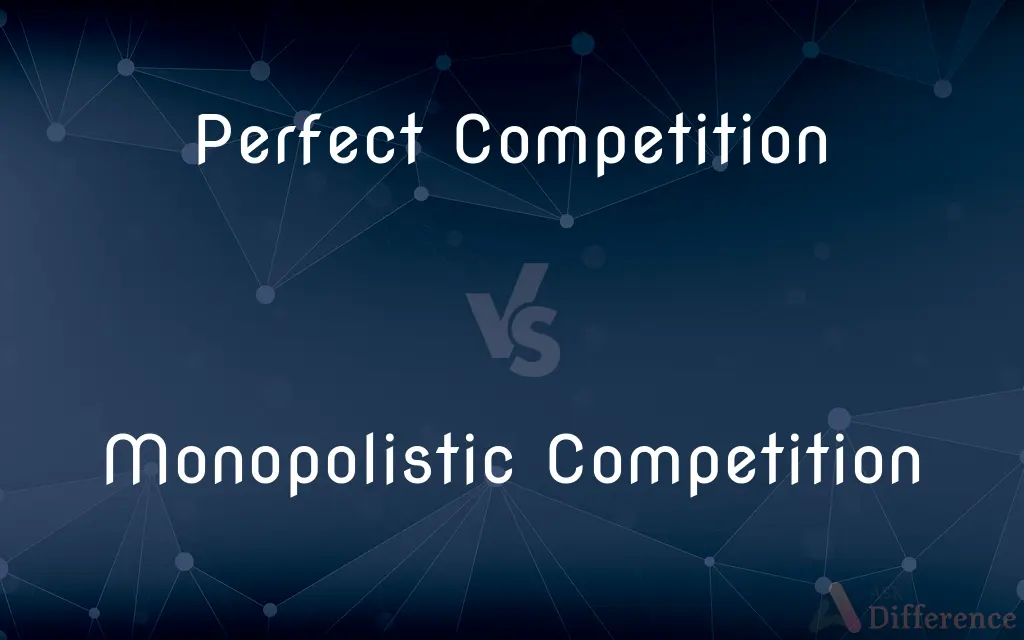Perfect Competition vs. Monopolistic Competition — What's the Difference?
By Tayyaba Rehman — Published on October 7, 2023
Perfect Competition has many sellers with identical products and price-takers, whereas Monopolistic Competition has many sellers with differentiated products and some price control.

Difference Between Perfect Competition and Monopolistic Competition
Table of Contents
ADVERTISEMENT
Key Differences
In Perfect Competition, the market consists of many sellers providing identical, undifferentiated products, resulting in consumers having no preference over the supplier. Price is determined by market equilibrium, where supply equals demand, leaving sellers as price-takers, with no control over the price. Consumers have perfect information, and there's free entry and exit from the market, making the earning of economic profit in the long run impossible.
Conversely, Monopolistic Competition represents a market structure where numerous sellers offer varied and differentiated products. Sellers in this model have some degree of market power allowing them to set prices to a certain extent. Product differentiation can result from quality, design, location, or promotional activity. Since products are not identical, consumer preference plays a significant role, and brand loyalty can be established.
Perfect Competition is theoretically efficient; resource allocation is optimal, production occurs where marginal cost equals marginal revenue, and prices reflect the total cost of production, including the opportunity cost. However, it may be argued that this form of competition is largely theoretical and rarely exists in its pure form in real-world markets due to its strict conditions.
Monopolistic Competition, while featuring inefficient resource allocation and excess capacity, allows for product variety and innovation, fulfilling diverse consumer needs and preferences. It is a more realistic representation of market structures, especially in retail markets, where differentiation and variety are prevalent.
To summarize, Perfect Competition and Monopolistic Competition contrast in terms of product uniformity, price control, consumer preference, and efficiency. Perfect Competition leads to optimal resource allocation with identical products, while Monopolistic Competition offers product variety and innovation with some degree of price control.
ADVERTISEMENT
Comparison Chart
Product Differentiation
No differentiation, identical products.
Products are differentiated and varied.
Market Power
Sellers are price-takers with no control over prices.
Sellers have some degree of price control.
Number of Sellers
Many sellers providing identical products.
Many sellers providing varied products.
Efficiency
Allocative and productive efficiency is achieved.
Inefficiencies and excess capacity exist.
Consumer Preference
No consumer preference due to uniform products.
Consumer preference is significant due to product variety.
Compare with Definitions
Perfect Competition
It denotes a theoretical market where no participant has market power to set the price.
Perfect Competition is considered economically efficient as products are sold at a price equal to marginal cost.
Monopolistic Competition
It implies a market scenario with free entry and exit but with firms possessing some price-setting power due to product differentiation.
Retail markets exemplify Monopolistic Competition, with stores providing distinct products and brands.
Perfect Competition
A conceptual market structure where firms are price-takers and the allocation of resources is optimal.
Economists use Perfect Competition as a benchmark to identify deviations in real-world market structures.
Monopolistic Competition
A market scenario enabling consumer choice and product diversity with sellers enjoying some degree of brand loyalty.
The fashion industry illustrates Monopolistic Competition, with brands differentiating themselves through style and quality.
Perfect Competition
It represents an ideal market with free entry and exit and no economic profit in the long run.
The stock market is sometimes likened to Perfect Competition as securities are largely homogeneous.
Monopolistic Competition
A market characterized by multiple sellers offering varied and distinguishable products.
The cosmetic industry is a model of Monopolistic Competition, marked by brand differentiation and advertising.
Perfect Competition
A market structure characterized by a large number of sellers providing identical products.
In a scenario of Perfect Competition, individual firms cannot influence market prices and must accept them as given.
Monopolistic Competition
It represents a competitive market setup where firms can earn short-run profits but are driven to normal profits in the long run due to entry of new firms.
In Monopolistic Competition, advertising plays a critical role in shaping consumer preferences and brand loyalty.
Perfect Competition
A market scenario where there is no scope for differentiation and consumers have perfect information.
Agricultural markets are often cited as examples of Perfect Competition due to the uniformity of products.
Monopolistic Competition
A market structure where many firms offer products that are substitutes but differentiated in some way.
Fast-food restaurants operate under Monopolistic Competition, offering similar yet varied menus.
Common Curiosities
What is Perfect Competition?
Perfect Competition is a market structure with many sellers, identical products, and no price control.
What defines Monopolistic Competition?
Monopolistic Competition involves many sellers with differentiated products and some degree of price control.
Is Perfect Competition realistic?
It is more theoretical due to its strict conditions, like identical products and perfect information, rarely met in real markets.
Can firms earn profits in Perfect Competition?
In the long run, firms break even; short-term profits attract competition, eliminating excess profits.
Do brands matter in Monopolistic Competition?
Yes, brands matter as products are differentiated; brand loyalty and advertising are significant.
What is the efficiency level in Perfect Competition?
It is highly efficient; products are produced and sold at the lowest possible cost.
How is consumer preference handled in Perfect Competition?
Consumers have no preference as products are identical.
Is product differentiation possible in Perfect Competition?
No, products are identical; no scope for differentiation.
Are there many sellers in Perfect Competition?
Yes, there are numerous sellers providing identical, undifferentiated products.
How prevalent is Monopolistic Competition?
It is quite common, especially in retail, where product differentiation and varied offerings are the norm.
How significant is advertising in Monopolistic Competition?
Extremely significant; advertising helps in product differentiation and establishing brand loyalty.
Is Monopolistic Competition efficient?
It is less efficient due to product differentiation leading to excess capacity and markup over marginal cost.
Does Monopolistic Competition allow for consumer preference?
Yes, consumer preference is significant due to the availability of varied and differentiated products.
Are there any barriers to entry in Perfect Competition?
No, there are no barriers, allowing free entry and exit of firms.
Can firms in Monopolistic Competition set prices?
Yes, to some extent, due to product differentiation.
Share Your Discovery

Previous Comparison
Difficulty vs. Obstacle
Next Comparison
Strike vs. LockoutAuthor Spotlight
Written by
Tayyaba RehmanTayyaba Rehman is a distinguished writer, currently serving as a primary contributor to askdifference.com. As a researcher in semantics and etymology, Tayyaba's passion for the complexity of languages and their distinctions has found a perfect home on the platform. Tayyaba delves into the intricacies of language, distinguishing between commonly confused words and phrases, thereby providing clarity for readers worldwide.












































